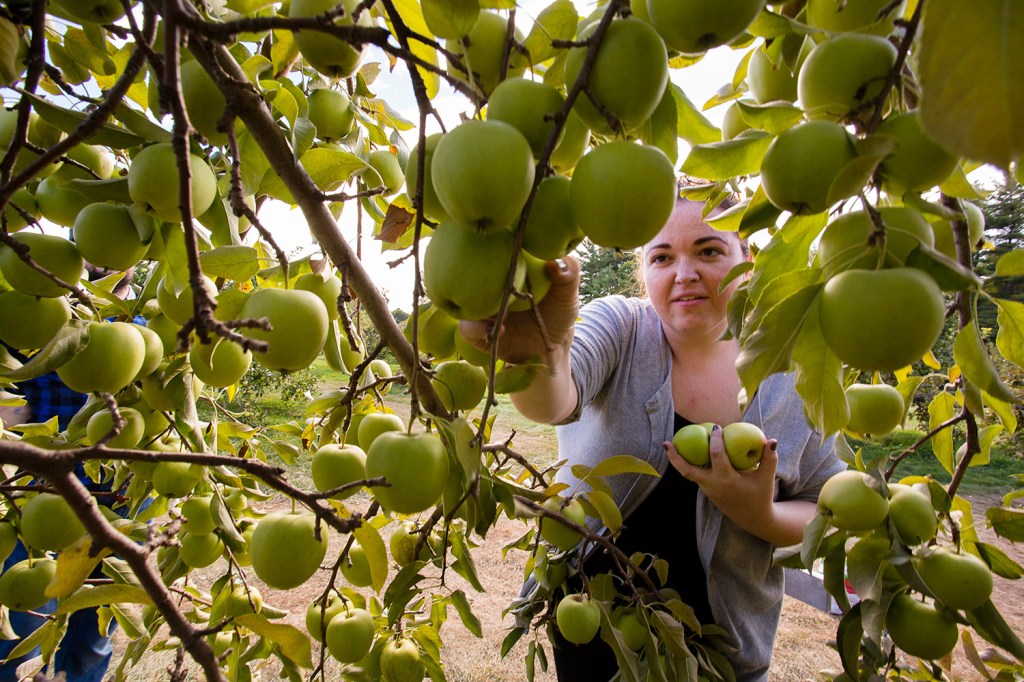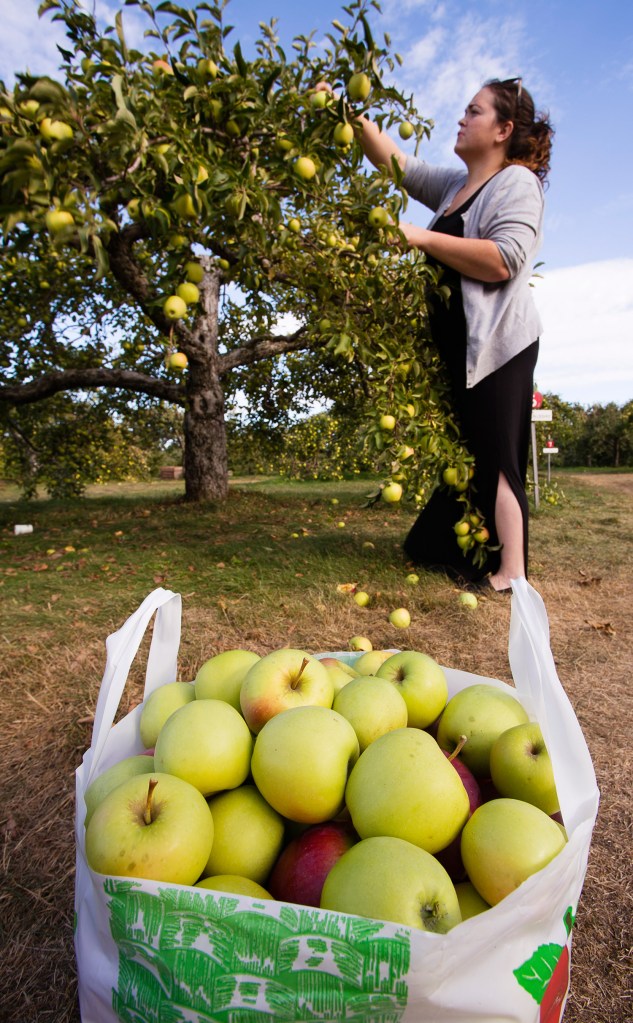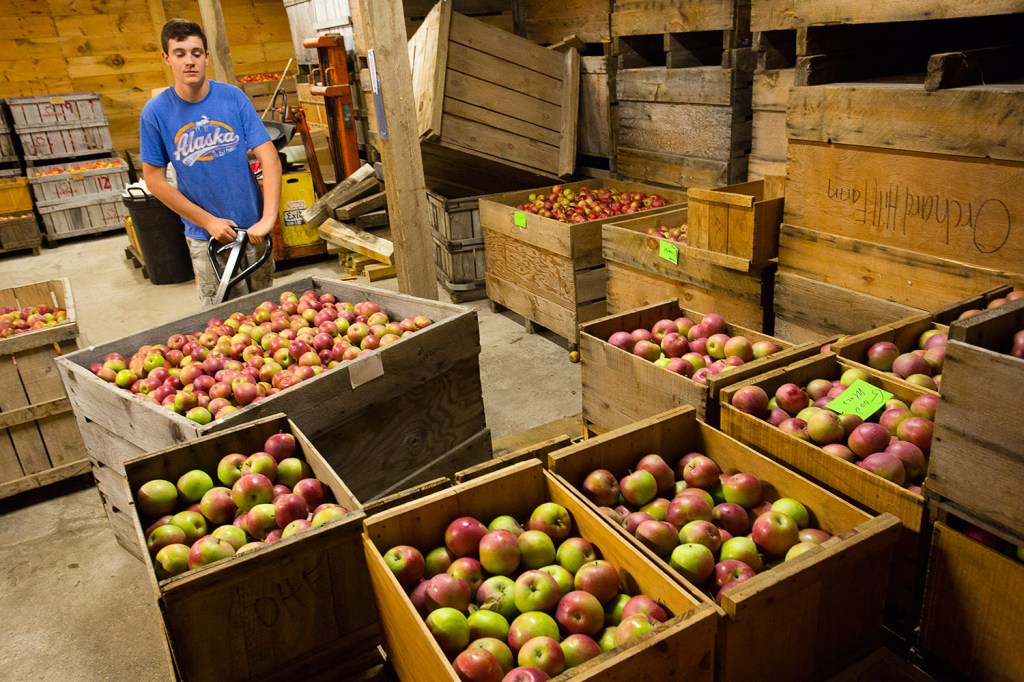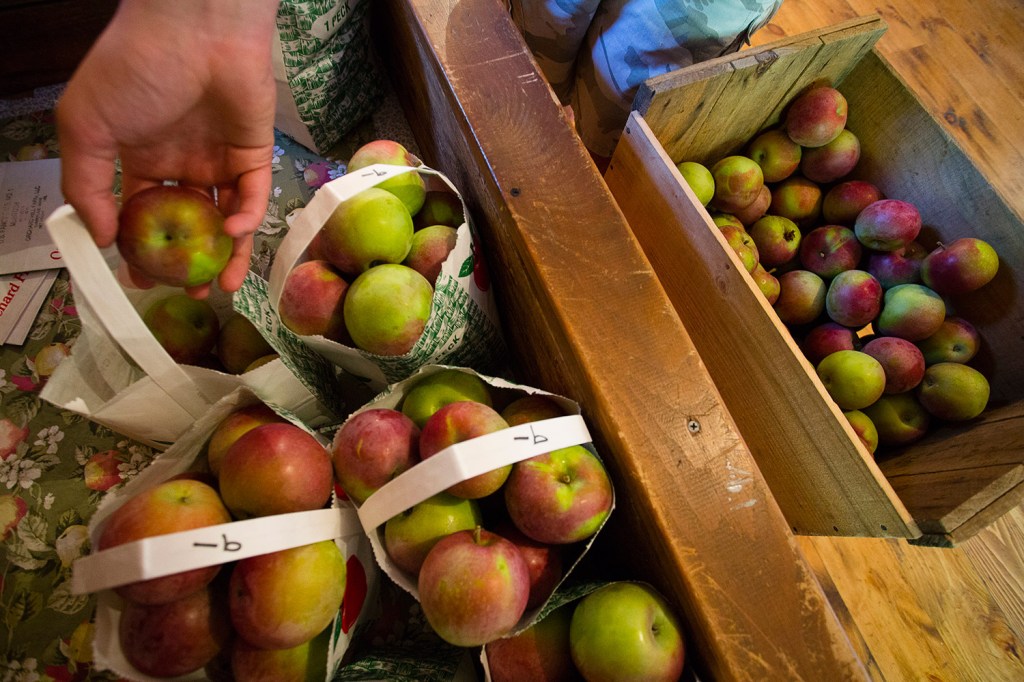CUMBERLAND — Long before the first Cortland, Honeycrisps or McIntoshes began to appear on tree limbs, Erin Pierce knew they were in for a busy fall on the family’s 25-acre apple orchard and farm.
“We had huge snow-white blooms – just snow-white. It was beautiful,” said Pierce, co-owner of Orchard Hill Farm. “So we could tell we were going to have a good crop.”
In fact, Maine’s apple crop is so good this year that at some orchards the trees can’t even keep their branches off the ground. As Pierce wandered among the acres of twisted trees loaded down with red and green fruit, she pointed to trees where a 2-year-old would have to stoop to pick fruit still attached to a branch.
“The trees are just very laden and weighed down this year,” she said.
Experts and apple orchard owners say a combination of factors is likely behind this year’s bumper crop. Apple trees tend to be cyclical, so this year’s higher yield follows a lighter harvest last year. Good spring and summer weather also played a role, although the warm late-summer conditions have pushed back the ripening for some popular varieties by a week or two.
“The cold nights and warm days are what we are after,” said Marilyn Meyerhans, whose family operates two orchards, The Apple Farm in Fairfield and Lakeside Orchards in Manchester. One of those orchards suffered hail damage during a freak spring storm, but Meyerhans was still expecting a strong year thanks to the abundance on the other trees. Plus, the damaged fruit will be “good cider instead.”
“It’s a good year,” Meyerhans said. “I think most of the farms in the state will do well. But because there are so many apples, as consumers I think we need to think apples all year because some apple (stockpiles) are going to last into the spring.”
While not necessarily ideal for limb health, an “overabundance” of apples – a phrase used repeatedly this week – is certainly not the worst problem for Maine orchards to have at a time when per-capita apple consumption is rising year over year and consumers are seeking out new varieties.
“Some of us will probably have apples until July,” said Renae Moran, an apple and tree fruit specialist with the University of Maine Cooperative Extension. “People like to see a lot of apples, but (orchards) are going to have to contend with a weaker wholesale market. But it’s been a great year for pick-your-own.”
TRENDS: PICK-YOUR-OWN, MORE VARIETIES
Maine farmers have been growing apples commercially for at least 200 years. Today the value of Maine’s apple crop – worth roughly $13 million in 2013, the most recent figure available – is far below that of blueberries and potatoes, and pales in comparison to such apple-growing powerhouses as Washington and New York.
Maine’s apple harvest, as reported by the U.S. Department of Agriculture, fluctuates considerably from year to year, ranging from a high of 47 million pounds in 2004 to just 23.5 million pounds two years later. However, the number of apple-producing acres has dropped steadily, from 3,500 in 2004 to 2,900 in 2013.
Americans consumed roughly 45.4 pounds of apples each in 2013 – whether as fresh fruit or as juice or in other forms – which was up from 42.4 pounds two years earlier, according to federal statistics.
But apples remain an important commodity, both for farmers and consumers, said Walter Whitcomb, commissioner of the Maine Department of Agriculture, Conservation and Forestry. Many orchards are scaling their operations to take advantage of the booming interest in pick-your-own apples – or strawberries, raspberries and pumpkins – and the state is taking a more active role in promoting the industry through events like Maine Apple Sunday, held Sept. 13 this year.
Whitcomb said the state’s apple growers are changing with the tastes of customers, who are increasingly looking for a greater variety than just Red Delicious or Granny Smiths.
“You have a great combination of heritage apples that people are beginning to like once again, and then you have new varieties,” Whitcomb said. “People’s tastes change, and apples are a great fruit that we grow here that we can experiment with.”
WISHING FOR CONSISTENCY IN CROP SIZE
Just down the road from Orchard Hill Farm near the Cumberland County fairgrounds, Lindsay Tiedemann at Sweetser’s Apple Barrel and Orchard said 2015 has been “phenomenal” so far. Sweetser’s grows about 50 varieties of apples, from popular Honeycrisps to the obscure Black Oxford. The latter variety, which originated in Oxford County in the 1700s, sold out quickly to special-request buyers, who snatched up the 20 or so apples that grew this year.
“Last year wasn’t great,” Tiedemann said of the harvest, “but this year has been bountiful.”
Moran, with the cooperative extension, said producing so much fruit does sap a lot of energy out of trees, so she expects next year to be a smaller crop with few blooms. Some orchards also may not be as “winter hardy” this year, although she said apple trees tend to be hardy.
“We like to have a consistent crop year after year (for market reasons), but for some reason this year the trees produced a huge amount of flowers,” Moran said.
Back at Orchard Hill Farm in Cumberland, the Pierce family is diversifying its products by pressing cider, making apple cider doughnuts, planting more pick-your-own highbush blueberry plants, operating its own honeybee hive system and offering hayrides.
But with the largest apple crop in their decade in business, Pierce said they might still be picking apples as Christmas approaches or until the snow flies.
Send questions/comments to the editors.







Comments are no longer available on this story